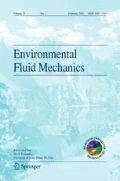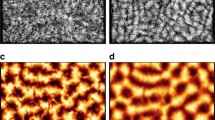Abstract
The simultaneous observations from a Doppler weather radar and an instrumented micrometeorological tower, offer an opportunity to dissect the effects of a gust front on the surface layer turbulence in a tropical convective boundary layer. We present a case study where a sudden drop in temperature was noted at heights within the surface layer during the passage of a gust front in the afternoon time. Consequently, this temperature drop created an interface which separated two different turbulent regimes. In one regime the turbulent temperature fluctuations were large and energetic, whereas in the other regime they were weak and quiescent. Given its uniqueness, we investigated the size distribution and aggregation properties of the turbulent structures related to these two regimes. We found that, the size distributions of the turbulent structures for both of these regimes displayed a clear power-law signature. Since power-laws are synonymous with scale-invariance, this indicated the passing of the gust front initiated a scale-free response which governed the turbulent characteristics of the temperature fluctuations. We propose a hypothesis to link such behaviour with the self-organized criticality as observed in the complex systems. However, the temporal organization of the turbulent structures, as indicated by their clustering tendencies, differed between these two regimes. For the regime corresponding to large temperature fluctuations, the turbulent structures were significantly clustered, whose clustering properties changed with height. Contrarily, for the other regime where the temperature fluctuations were weak, the turbulent structures remained less clustered with no discernible change being observed with height.








Similar content being viewed by others
Data Availability Statement
On reasonable request, the datasets analysed during the current study can be made available to the interested researchers by contacting Thara V Prabha (thara@tropmet.res.in). The computer codes needed to reproduce the figures are available by contacting the corresponding author Subharthi Chowdhuri at subharthi.cat@tropmet.res.in.
References
Açıkalın ŞN, Artun EC (2017) The concept of self-organized criticality: The case study of the Arab uprising. In: International symposium on Chaos, complexity and leadership. Springer, pp 73–85
Adrian R, Ferreira R, Boberg T (1986) Turbulent thermal convection in wide horizontal fluid layers. Exp Fluids 4(3):121–141. https://doi.org/10.1007/BF00280263
Bak P, Tang C, Wiesenfeld K (1988) Self-organized criticality. Phys Rev A 38(1):364. https://doi.org/10.1103/PhysRevA.38.364
Balachandar S, Sirovich L (1991) Probability distribution functions in turbulent convection. Phys Fluids 3(5):919–927. https://doi.org/10.1063/1.857968
Barenblatt GI (1996) Scaling, self-similarity, and intermediate asymptotics: dimensional analysis and intermediate asymptotics, vol 14. Cambridge University Press, Cambridge
Bershadskii A, Niemela J, Praskovsky A, Sreenivasan K (2004) Clusterization and intermittency of temperature fluctuations in turbulent convection. Phys Rev E 69(5):056314. https://doi.org/10.1103/PhysRevE.69.056314
Blumen W, Grossman R, Piper M (1999) Analysis of heat budget, dissipation and frontogenesis in a shallow density current. Bound-Layer Meteorol 91(2):281–306. https://doi.org/10.1023/A:1001813700928
Cava D, Katul G (2009) The effects of thermal stratification on clustering properties of canopy turbulence. Bound-Layer Meteorol 130(3):307. https://doi.org/10.1007/s10546-008-9342-6
Cava D, Katul G, Molini A, Elefante C (2012) The role of surface characteristics on intermittency and zero-crossing properties of atmospheric turbulence. J Geophys Res Atmos 117(D1):1. https://doi.org/10.1029/2011JD016167
Cava D, Mortarini L, Giostra U, Acevedo O, Katul G (2019) Submeso motions and intermittent turbulence across a nocturnal low-level jet: a self-organized criticality analogy. Bound-Layer Meteorol 172(1):17–43. https://doi.org/10.1007/s10546-019-00441-8
Chamecki M (2013) Persistence of velocity fluctuations in non-Gaussian turbulence within and above plant canopies. Phys Fluids 25(11):115110. https://doi.org/10.1063/1.4832955
Chowdhuri S, Kalmár-Nagy T, Banerjee T (2020a) Persistence analysis of velocity and temperature fluctuations in convective surface layer turbulence. Phys Fluids 32(7):076601. https://doi.org/10.1063/5.0013911
Chowdhuri S, Kumar S, Banerjee T (2020b) Revisiting the role of intermittent heat transport towards Reynolds stress anisotropy in convective turbulence. J Fluid Mech 899:A26. https://doi.org/10.1017/jfm.2020.471
Chu C, Parlange M, Katul G, Albertson J (1996) Probability density functions of turbulent velocity and temperature in the atmospheric surface layer. Water Resour Res 32(6):1681–1688. https://doi.org/10.1029/96WR00287
Davidson P (2015) Turbulence: an introduction for scientists and engineers. Oxford University Press, Oxford
Doviak RJ, Ge R (1984) An atmospheric solitary gust observed with a doppler radar, a tall tower and a surface network. J Atmos Sci 41(17):2559–2573. https://doi.org/10.1175/1520-0469(1984)041<2559:AASGOW>2.0.CO;2
Droegemeier KK, Wilhelmson RB (1985) Three-dimensional numerical modeling of convection produced by interacting thunderstorm outflows: Part I: Control simulation and low-level moisture variations. J Atmos Sci 42(22):2381–2403. https://doi.org/10.1175/1520-0469(1985)042<2381:TDNMOC>2.0.CO;2
Foken T, Wichura B (1996) Tools for quality assessment of surface-based flux measurements. Agric Forest Meteorol 78(1–2):83–105. https://doi.org/10.1016/0168-1923(95)02248-1
Garai A, Kleissl J (2013) Interaction between coherent structures and surface temperature and its effect on ground heat flux in an unstably stratified boundary layer. J Turbul 14(8):1–23. https://doi.org/10.1080/14685248.2013.806812
Hutson AL (2017) Using mobile doppler radar observations of gust fronts to infer buoyancy deficits. PhD thesis, Texas Tech University. https://ttu-ir.tdl.org/handle/2346/72719
Kader B, Yaglom A (1991) Spectra and correlation functions of surface layer atmospheric turbulence in unstable thermal stratification. In: Turbulence and Coherent Structures. Springer, pp 387–412
Kailasnath P, Sreenivasan K (1993) Zero crossings of velocity fluctuations in turbulent boundary layers. Phys Fluids 5(11):2879–2885. https://doi.org/10.1063/1.858697
Kaimal JC, Finnigan JJ (1994) Atmospheric boundary layer flows: their structure and measurement. Oxford University Press, Oxford
Kalmár-Nagy T, Varga Á (2019) Complexity analysis of turbulent flow around a street canyon. Chaos Soliton Fract 119:102–117. https://doi.org/10.1016/j.chaos.2018.12.010
Katul G, Hsieh C-I, Sigmon J (1997) Energy-inertial scale interactions for velocity and temperature in the unstable atmospheric surface layer. Bound-Layer Meteorol 82(1):49–80. https://doi.org/10.1023/A:1000178707511
Khanna S, Brasseur J (1998) Three-dimensional buoyancy-and shear-induced local structure of the atmospheric boundary layer. J Atmos Sci 55(5):710–743. https://doi.org/10.1175/1520-0469(1998)055<0710:TDBASI>2.0.CO;2
Kingsmill DE (1995) Convection initiation associated with a sea-breeze front, a gust front, and their collision. Mon Weather Rev 123(10):2913–2933. https://doi.org/10.1175/1520-0493(1995)123<2913:CIAWAS>2.0.CO;2
Kulkarni J, Maheskumar R, Morwal S, Padmakumari B, Konwar M, Deshpande C, Joshi R, Bhalwankar R, Pandithurai G, Safai P et al (2012) The cloud aerosol interactions and precipitation enhancement experiment (CAIPEEX): overview and preliminary results. Curr Sci 102(3):413–425
Lewis TG (2010) Cause-and-effect or fooled by randomness? Homeland Security Affairs 6(1):1. https://www.hsaj.org/articles/93
Li D, Katul GG, Bou-Zeid E (2012) Mean velocity and temperature profiles in a sheared diabatic turbulent boundary layer. Phys Fluids 24(10):105105. https://doi.org/10.1063/1.4757660
Liu L, Hu F, Cheng X (2011) Probability density functions of turbulent velocity and temperature fluctuations in the unstable atmospheric surface layer. J Geophys Res Atmos 116(D12):1. https://doi.org/10.1029/2010JD015503
Lyu R, Hu F, Liu L, Xu J, Cheng X (2018) High-order statistics of temperature fluctuations in an unstable atmospheric surface layer over grassland. Adv Atmos Sci 35(10):1265–1276. https://doi.org/10.1007/s00376-018-7248-x
Mahrt L (2019) Microfronts in the nocturnal boundary layer. Q J R Meteorol Soc 145(719):546–562. https://doi.org/10.1002/qj.3451
Majumdar SN (1999) Persistence in nonequilibrium systems. Curr Sci 1:370–375
Mueller CK, Carbone RE (1987) Dynamics of a thunderstorm outflow. J Atmos Sci 44(15):1879–1898. https://doi.org/10.1175/1520-0469(1987)044<1879:DOATO>2.0.CO;2
Newman ME (2005) Power laws, pareto distributions and zipf’s law. Contemp Phys 46(5):323–351. https://doi.org/10.1080/00107510500052444
Oliveira MI, Acevedo OC, Sörgel M, Nascimento EL, Manzi AO, Oliveira PE, Brondani DV, Tsokankunku A, Andreae MO (2020) Planetary boundary layer evolution over the amazon rainforest in episodes of deep moist convection at the amazon tall tower observatory. Atmos Chem Phys 20(1):15–27. https://doi.org/10.5194/acp-20-15-2020
Poggi D, Katul G (2009) Flume experiments on intermittency and zero-crossing properties of canopy turbulence. Phys Fluids 21(6):065103. https://doi.org/10.1063/1.3140032
Pouransari Z, Biferale L, Johansson A (2015) Statistical analysis of the velocity and scalar fields in reacting turbulent wall-jets. Phys Fluids 27(2):025102. https://doi.org/10.1063/1.4906370
Prabha TV, Khain A, Maheshkumar R, Pandithurai G, Kulkarni J, Konwar M, Goswami B (2011) Microphysics of premonsoon and monsoon clouds as seen from in situ measurements during the cloud aerosol interaction and precipitation enhancement experiment (CAIPEEX). J Atmos Sci 68(9):1882–1901. https://doi.org/10.1175/2011JAS3707.1
Prabha TV, Leclerc MY, Karipot A, Hollinger DY (2007) Low-frequency effects on eddy covariance fluxes under the influence of a low-level jet. J Appl Meteorol Clim 46(3):338–352. https://doi.org/10.1175/JAM2461.1
Riganti CJ, Houston AL (2017) Rear-flank outflow dynamics and thermodynamics in the 10 June 2010 Last Chance, Colorado, supercell. Mon Weather Rev 145(7):2487–2504. https://doi.org/10.1175/MWR-D-16-0128.1
Sreenivasan K, Bershadskii A (2006) Clustering properties in turbulent signals. J Stat Phys 125(5–6):1141–1153. https://doi.org/10.1007/s10955-006-9112-0
Sreenivasan K, Prabhu A, Narasimha R (1983) Zero-crossings in turbulent signals. J Fluid Mech 137:251–272. https://doi.org/10.1017/S0022112083002396
Tennekes H, Lumley J (1972) A first course in turbulence. MIT Press, Cambridge
Verma M, Manna S, Banerjee J, Ghosh S (2006) Universal scaling laws for large events in driven nonequilibrium systems. EPL 76(6):1050. https://doi.org/10.1209/epl/i2006-10413-1
Wang Y, He X, Tong P (2019) Turbulent temperature fluctuations in a closed Rayleigh-Bénard convection cell. J Fluid Mech 874:263–284. https://doi.org/10.1017/jfm.2019.405
Weckwerth TM, Wakimoto RM (1992) The initiation and organization of convective cells atop a cold-air outflow boundary. Mon Weather Rev 120(10):2169–2187. https://doi.org/10.1175/1520-0493(1992)120<2169:TIAOOC>2.0.CO;2
Williams A, Hacker J (1992) The composite shape and structure of coherent eddies in the convective boundary layer. Bound-Layer Meteorol 61(3):213–245. https://doi.org/10.1007/BF02042933
Williams A, Hacker J (1993) Interactions between coherent eddies in the lower convective boundary layer. Bound-Layer Meteorol 64(1–2):55–74. https://doi.org/10.1007/BF00705662
Acknowledgements
Cloud Aerosol Interaction and Precipitation Enhancement Experiment (CAIPEEX) is conducted by the Indian Institute of Tropical Meteorology, which is an autonomous institute and fully funded by the Ministry of Earth Sciences, Government of India. Authors are grateful to several colleagues who contributed to the success of the CAIPEEX project. The authors also acknowledge the local support and hospitality provided by N. B. Navale Sinhgad College of Engineering (NBNSCOE), Kegaon-Solapur, during the experiment. The author Subharthi Chowdhuri expresses his gratitude to Dr. Tirtha Banerjee and Dr. Tamás Kalmár-Nagy for many fruitful discussions on the concepts of persistence, zero-crossing densities, and SOC phenomenon. The helpful comments of the anonymous reviewers are also gratefully acknowledged.
Author information
Authors and Affiliations
Contributions
The authors Subharthi Chowdhuri and Thara V Prabha conceptualized the study. The data collection was performed by Subharthi Chowdhuri, Kiran Todekar, Anand K Karipot, and Palani Murugavel. All the analyses for the paper were carried out by Subharthi Chowdhuri. The first draft of the manuscript was written by Subharthi Chowdhuri and all authors commented on previous versions of the manuscript. All authors read and approved the final manuscript.
Corresponding author
Ethics declarations
Conflict of Interest
The authors declare that they have no conflict of interest.
Additional information
Publisher's Note
Springer Nature remains neutral with regard to jurisdictional claims in published maps and institutional affiliations.
Electronic supplementary material
Below is the link to the electronic supplementary material.
Rights and permissions
About this article
Cite this article
Chowdhuri, S., Todekar, K., Murugavel, P. et al. Unravelling the turbulent structures of temperature variations during a gust front event: a case study. Environ Fluid Mech 21, 263–281 (2021). https://doi.org/10.1007/s10652-020-09769-z
Received:
Accepted:
Published:
Issue Date:
DOI: https://doi.org/10.1007/s10652-020-09769-z




